Welcome to the sixth installment of our ballistic gel testing series. The current series is sponsored by Clark Armory who provided the testing medium and rounds:
About a month ago Nicholas C posted an article showing a comparison video of organic ballistic gelatin to Clear Ballistics that was done by ar15.com. There was quite a lively discussion in the comments. Tom G and I did feel that that comparison was invalid since the density of the gels were not consistent. Obviously a gel with a lower density is going to show deeper penetration–so evaluating round penetration in gel (either kind of gel) is going to be skewed. If it is not calibrated and you are trying to control against a specific density, your results are going to be skewed. End of story. There are apparently factions of gel testers out there: the #neverclearballistics and the #dontcaresolongasitisconsistent. Tom G and I fall into the latter. I personally could care less, so long as the medium is calibrated and consistent (and I’ll shoot what ever they send me). There are important hills to die on–ballistic gel nerdology is not one of them. At the end of the day, shooting gel, is, well, shooting gel. If you want to know what a round will do to a person, then you need to test on a person. Which gets expensive and messy. And ultimately proves the point–round placement is everything. Caliber and gimmicky rounds just allow for sloppier round placement.
Technical Details of HPR Black Ops in 9mm
Black Ops OTF by HPR is designed to be the ultimate round in both terminal performance and accuracy. HPR Black Ops Ammo is loaded with BlackOps OTF frangible hollow point projectiles. These projectiles are designed to transfer 100% of its energy to the target upon impact and create a wound channel up to five times greater than the bullet’s original diameter.
HPR Black Ops in 9mm
- Caliber: 9mm
- Weight: 85 gr.
- Bullet: Open Tip Frangible
- Velocity: 1320 fps
- Energy: 329 ft. lbs.
About HPR:
At HPR, we pride ourselves in our American heritage. We use the finest USA made components, and every round is meticulously inspected by US Citizens. We strive to be the leading innovator of center-fire ammunition for military, law enforcement, and civilians. Every load is developed for a specific purpose with a focus on consistency, accuracy, and even,in some cases, felt recoil. Each round is designed, manufactured, inspected and packaged to bring you a superior shooting experience and the confidence to dominate downrange.
HPR Ammunition’s website: http://www.hprammo.com/
Test Parameters and Setup
With this test we are changing our format a little. We originally tested a single round into a gel, and conducted four tests: against bare gel, gel covered with several layers of clothing, gel behind drywall and gel behind automotive glass (both of the last two will also have a layer of clothing over them). And we also compared it to a known popular round.
Our new test format is going to fire six rounds into the same gel, and only test bare gel, and gel covered with “heavy clothing”. The rationale is that one round could be a zebra in a herd of horses (may have a totally different outcome). Firing multiple rounds normalizes that a tiny bit. From a purity standpoint, technically we should shoot into clean, and CALIBRATED, gel each time. If we start seeing huge variance we may do that (using clean gel; we calibrate each block). We are cutting out the drywall and auto glass tests due to the amazing mess that they make (to both the testing venue and the gel itself). While fun, they are probably not the most relevant tests (other than being in the “golden eight” from the original FBI test).
First order of business will be testing the density of the gel with a BB fired at a known rate. We will fire the BB into a corner of the gel. If it doesn’t pass, then we need to start over and use a gel that does since the results would not be consistent.
The test will look like this:
- Set up shooting position and recording devices
- Set up naked gel
- Fire BB at 500 to 600 feet per second at Gel and photograph penetration
- Fire round at gel while filming video and then photograph penetration from front, side and top.
- Repeat steps 3 to 5 with the other tests.
Test 1: Bare Gel
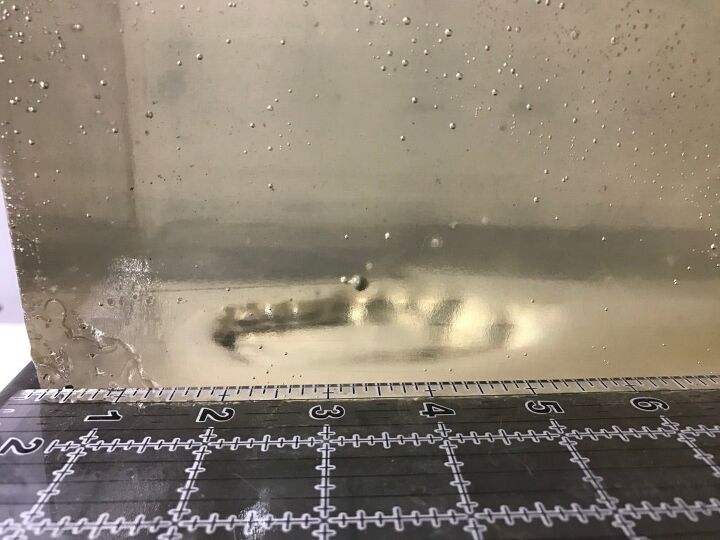
Bare Gel -BB
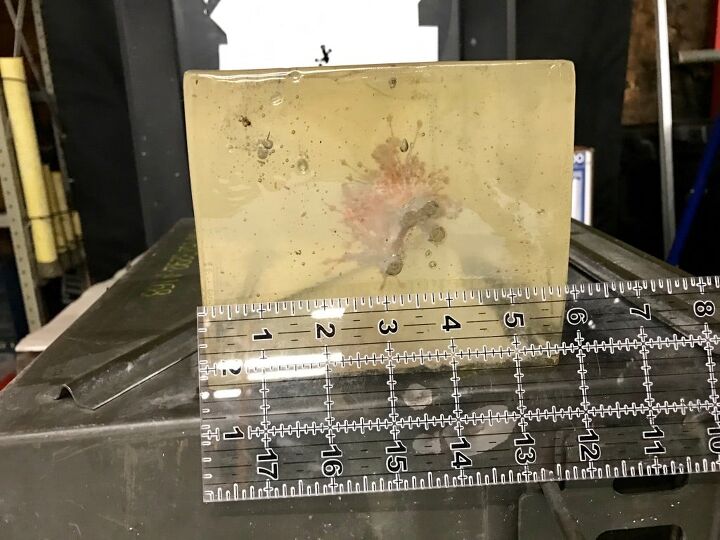
Bare Gel – Front
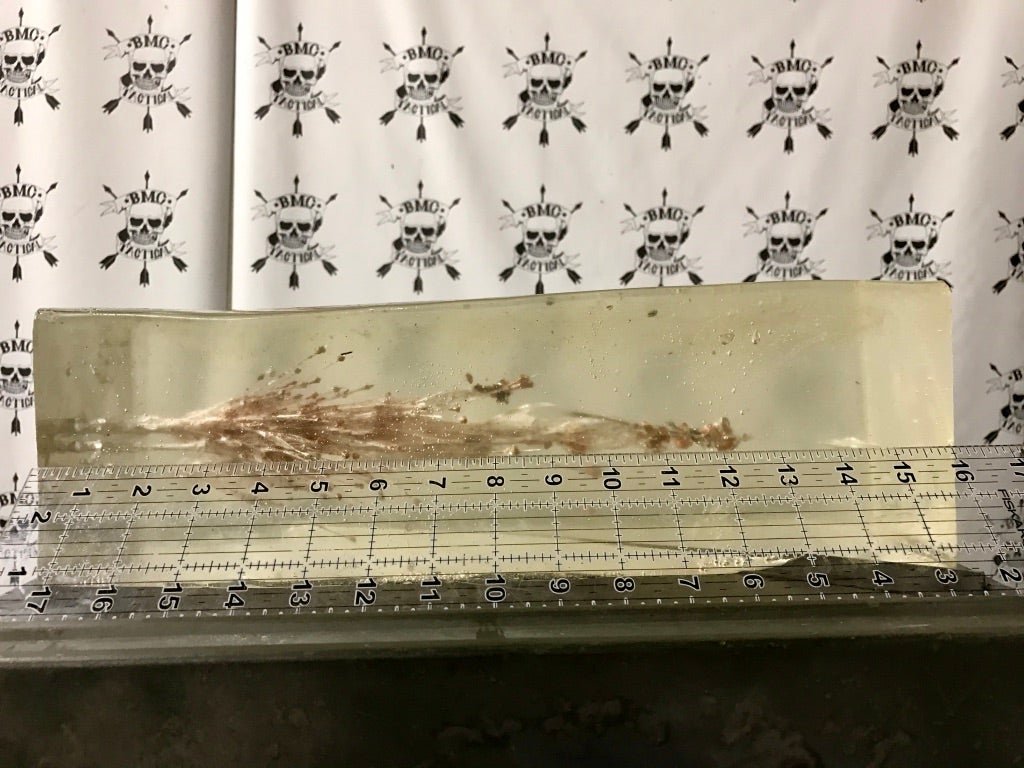
Bare Gel – Side
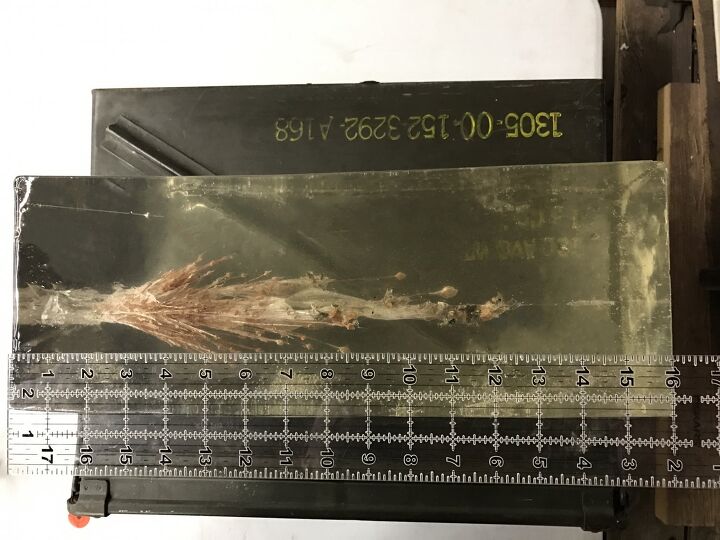
Bare Gel – Top
Findings
The Black Ops expended most of it’s energy between 2 inches and 4 inches. Most of the frangible portion petered out between 5 and 6 inches, with a few bits traveling further. In most cases the jacket came apart within the earlier mass, though we did see one end up around 12 inches (that could have been pushed by a subsequent round).
The Black Ops would not technically pass the FBI standards as a significant portion of the mass did not penetrate twelve inches–not that it claimed to, though. What it did do is create a hell of a mess, and we agree that the soft tissue damage would be impressive. And likely annoy any doctor having to clean it out.
Test 2: Heavy Clothing
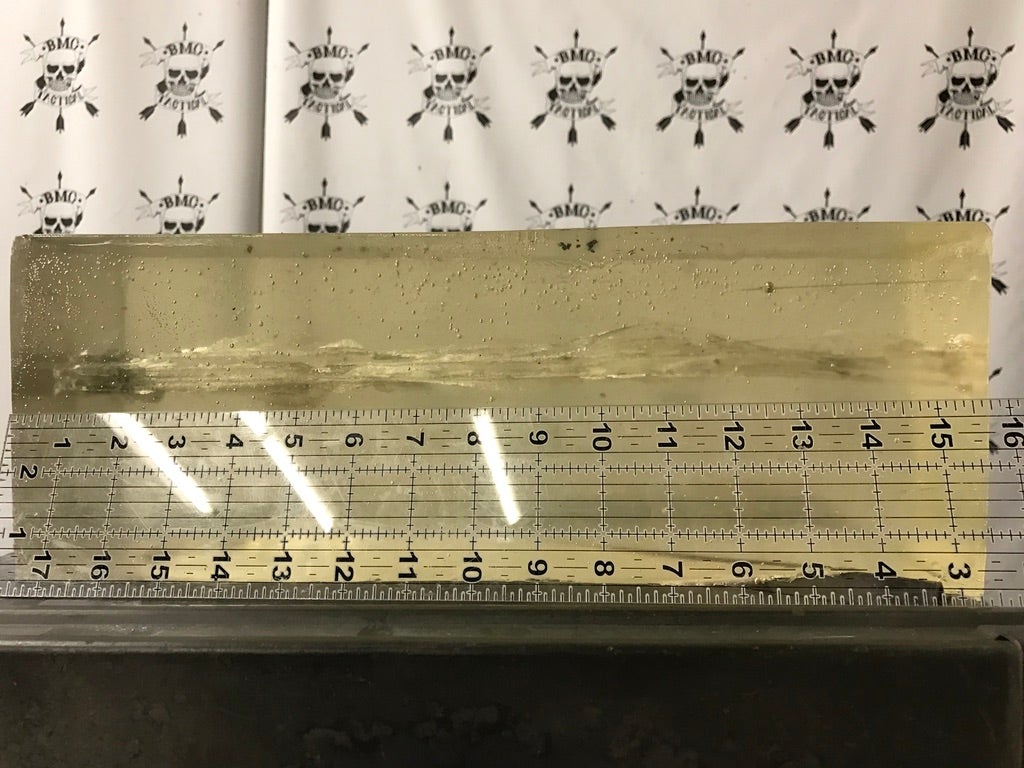
Heavy Clothing – BB – Sitting right at 3.25″ (through repeated resetting we have lost a little bit of material; I also forgot to take the pic before doing this shoot)
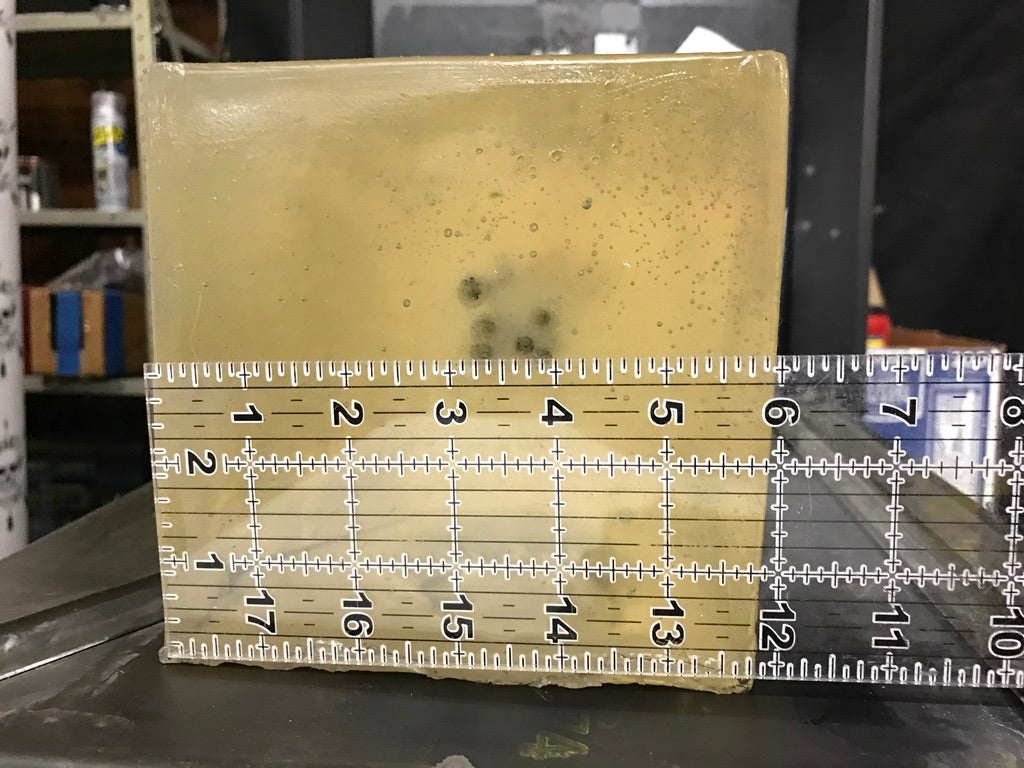
Heavy Clothing – Front
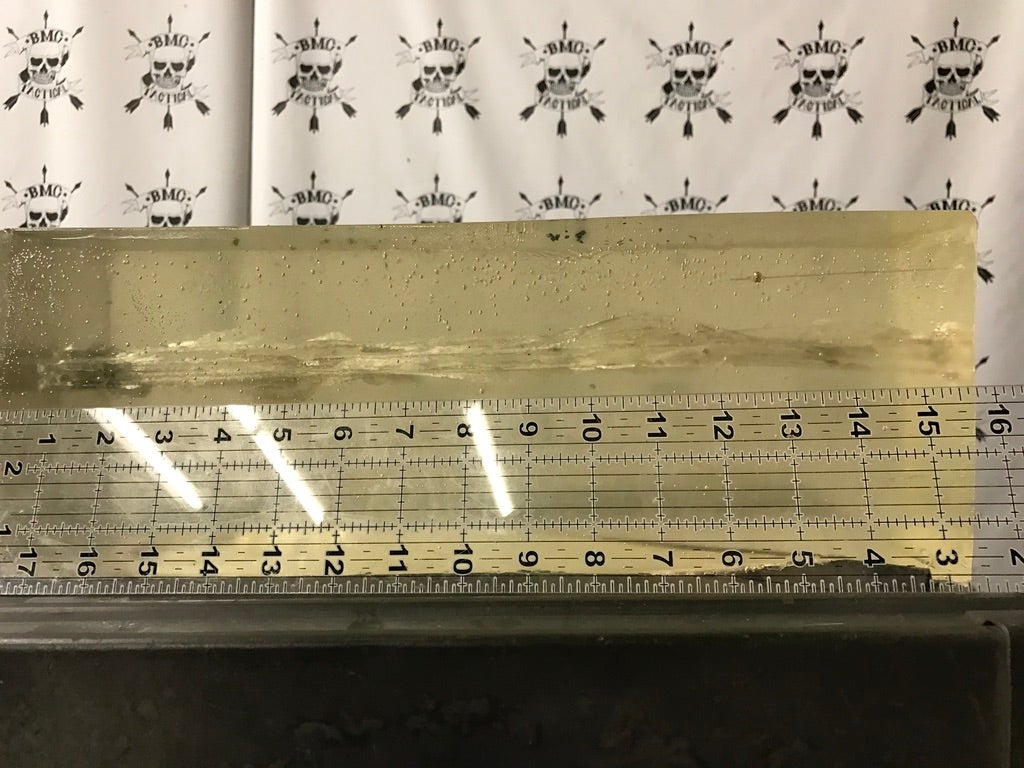
Heavy Clothing – Side

Heavy Clothing – Top
Findings
The Black Ops actually over-penetrated and exited the gel. Every single round. But this is not really unexpected. Most of the hollow point rounds we have seen exhibited the trait of picking up material and penetrating much further than did the rounds through bare Gel. The Black Ops behaved no differently. We were able to recover a couple of the rounds from the bullet trap, with the compressed innards still intact (though the jacket flowered nicely).
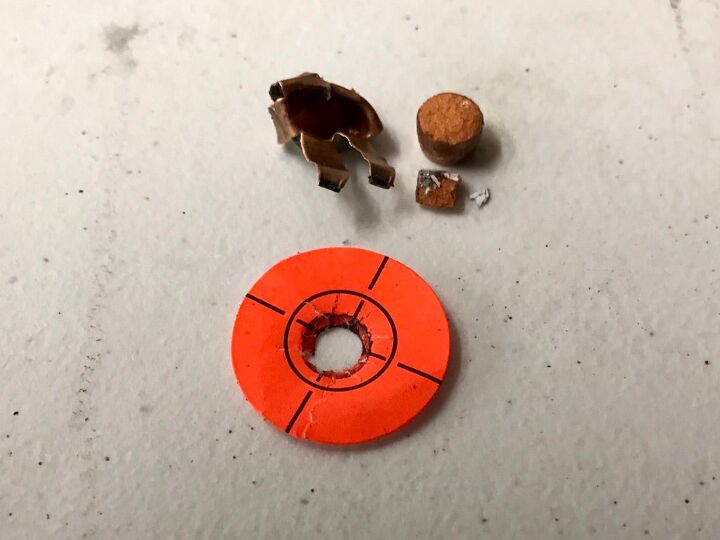
You can see the jacket expanded (after entering the bullet trap, and that compressed material slug was still mostlly inctact. We also recoved that once in a lifetime focus dot (which you can see fly off in the slo-mo video).
The Black ops would technically pass the FBI standards as a significant portion of the mass penetrated twelve inches. This is contrary to the advertising that their trademarked HyperExpansion would limit and reduce “over penetration”.
Conclusions
We shot this test using a Glock 17 outfitted with KE Arms new Charlie slide (and their Glock trigger replacement).
The round was consistent with advertising with respect to bare gel. It did over penetrate (as in at least 15.75 inches; we had a little lossage of material from the last reset) when passing through clothing. My guess is that if it impacted anything firm in the body (like bone) the round would come apart much like in the bare gel test. And in the video (through heavy clothing) you can see that it did create a pretty significant expansion.
We can debate the efficacy of the FBI standard (in the comments), but it is a pretty well defined and understood test at this point, and provides a good way to compare rounds.
Also a quick little footnote. The HPR plant is currently shutdown and it is not entirely clear when (or if) it is going to reopen: http://www.paysonroundup.com/news/2016/oct/04/hpr-ammunition-plant-shut-down/
Credits
Thanks to Clark Armory and BMC Tactical for sponsoring and supporting this test. Clark Armory provided the Ballistic Gel from ClearBallistics and the ammo (they sell the Black Ops: HPR 9mm Black Ops OTF).
BMC Tactical provided an indoor lane with consistent lighting and temperature to run the test.
We appreciate these two companies providing necessary materials and infrastructure for the tests.
 Your Privacy Choices
Your Privacy Choices
